Analyzing and applying social media statistics
Market research can be time-consuming, expensive and difficult to gather. Classic research practices such as surveys and focus groups can provide great insight. However, marketers often need feedback fast and traditional research methods do not always make the cut.
![]() This is where social media comes in. The communications world has begun to utilize social media as a key source of research information.
This is where social media comes in. The communications world has begun to utilize social media as a key source of research information.
Comments, likes and conversations that take place on social platforms provides marketers with real-time measurements.
Here are some of the top benefits of using social media as a research tool.
Customer sentiment
When forming a campaign, it is vital to have a strong understanding of customers feelings about the company and product.
According to SocialStrategy1, “Social media monitoring gives real-time access to opinions, data that dates back, and analysis of conversations that lie outside the typical survey participant, larger groups for sampling, agility in experimental proceedings.”
Due to comments and likes on social media, marketers can combine this qualitative and quantitative data into full reports.
For example, Facebook’s newly added “Facebook Reactions” allow users to express opinions beyond just liking a post. Now, users can have reactions including love, ‘haha’, ‘wow’, sadness and anger.
This data, when accumulated together, gives marketers constantly updated statistics on how people are reacting on social media to their company.
The amount of awareness
Social media also allows companies to see how many people are talking about their business or particular campaign.
 According to Brandwatch, many marketers attribute brand awareness to a higher return on investment.
According to Brandwatch, many marketers attribute brand awareness to a higher return on investment.
According to the same article, “One of the strongest drivers in making consumers buy is simply the ability to recall that product. ”
Tools such as Hootsuite and Google Analytics can measure the number of comments, mentions, retweets and traffic to certain social sites. These statistics are a strong representation of a customer’s brand awareness.
Evaluate, plan and communicate
Once this research is gathered, researchers can take what they found, apply it to their campaigns and grow their messaging.
An example of this is learning the audience’s language. 
According to Social Media Today, “The words and factors that you use to track the success of your product might not always align with what customers find most important. By analyzing social media exchanges about your product or service, you can learn what factors customers use to determine value as well as the way that they speak about your product, service or brand.”
Social media research helps form a digital plan by giving marketers information when trying to improve communication with key publics.












